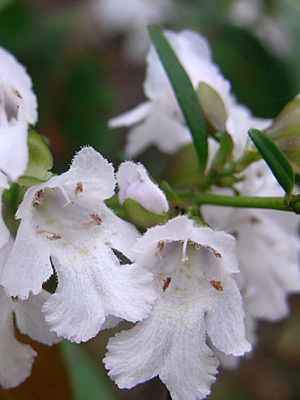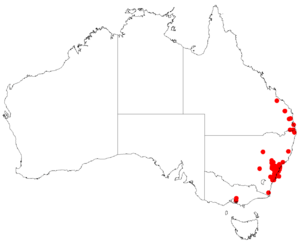Narrow-leaved mint-bush facts for kids
Quick facts for kids Narrow-leaved mint-bush |
|
|---|---|
 |
|
| In Lane Cove National Park | |
| Scientific classification | |
| Genus: |
Prostanthera
|
| Species: |
linearis
|
 |
|
| Occurrence data from AVH | |
The narrow-leaved mint-bush (scientific name: Prostanthera linearis) is a beautiful flowering plant. It belongs to the Lamiaceae family, which includes many mint plants. This shrub is special because it grows naturally only in eastern Australia. It's a tall, slightly fragrant bush with smooth, narrow leaves. Its flowers are usually white, sometimes with a touch of pink or purple.
Contents
What Does the Narrow-Leaved Mint-Bush Look Like?
The narrow-leaved mint-bush is a shrub that stands tall. It usually grows to be about 1 to 3 meters (3 to 10 feet) high. When you are near it, you might notice a faint, pleasant smell.
Leaves and Stems
Its leaves are smooth and have a narrow, egg-like shape. They can also be long and thin, like a line. These leaves are usually between 1.5 and 4.5 centimeters (about 0.6 to 1.8 inches) long. They are quite narrow, only about 2 to 3 millimeters wide. Each leaf sits on a very short stalk, less than 2 millimeters long.
Flowers and How They Grow
The flowers of the narrow-leaved mint-bush grow near the ends of the branches. They appear where the leaves meet the stem. At the bottom of each flower, there are small, leaf-like parts called bracteoles. These are about 2 to 3 millimeters long.
The flowers have special outer parts called sepals. These sepals are about 5.5 to 6 millimeters long. They form a small tube about 2 to 3 millimeters long. The top part of this tube has two lobes, with the upper lobe being about 2.5 to 3 millimeters long. The petals of the flower are usually white and can be 8 to 12 millimeters long. Sometimes, they have a lovely pink or purple tint.
How This Plant Got Its Name
The narrow-leaved mint-bush was first officially described in 1810. A famous botanist named Robert Brown gave it its scientific name. He wrote about it in his book Prodromus Florae Novae Hollandiae.
The second part of its scientific name, linearis, is a Latin word. It means "linear" or "like a line." This name was chosen because of the plant's long, narrow leaves.
Where Does the Mint-Bush Grow?
You can find the narrow-leaved mint-bush growing in eucalyptus forests. It often likes to be near streams. It prefers sandy or gravelly clay soils. This plant grows naturally in Queensland and in New South Wales, from Sydney all the way south to Milton.
Is This Plant Protected?
The narrow-leaved mint-bush is currently not considered to be in danger. The Queensland Government lists it as being of "least concern" under their Nature Conservation Act 1992. This means there are plenty of these plants around, and they are not at risk of disappearing.

